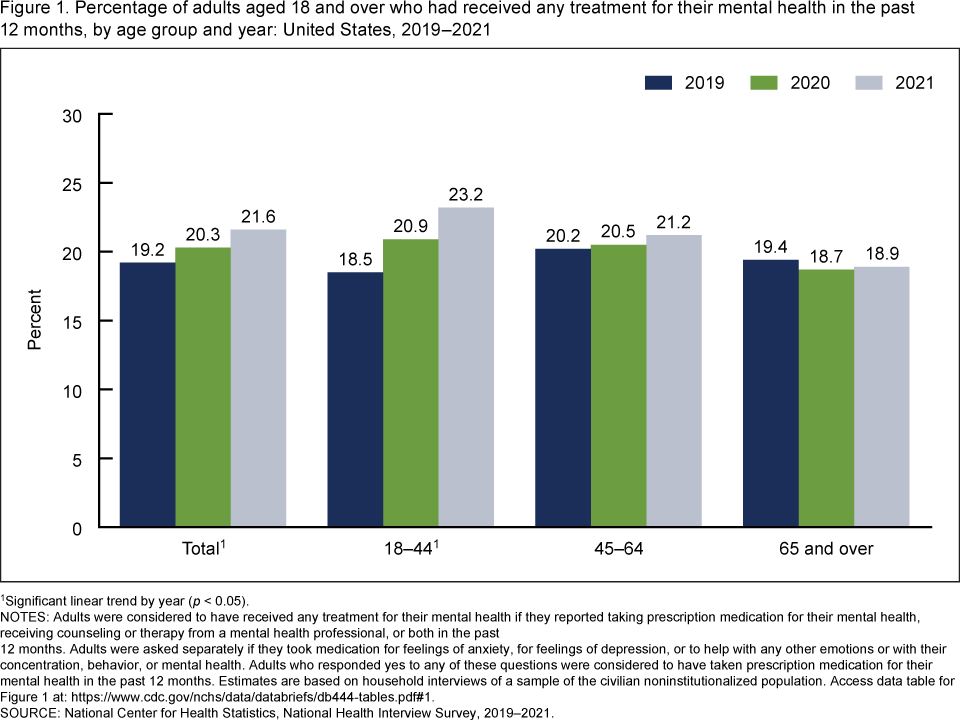Research shows that people seeking mental health treatment increased significantly between 2019 and 2021, with the overall percentage of young adults seeking treatment rising almost 5 percentage points.
This trend, presented in a recent study by the Centers for Disease Control and Prevention, follows research showing that symptoms of anxiety and depressive disorders increased from 2020 into early 2021 from 36.4% to 41.5%. Increases in these disorders were largest among adults aged 18–29 and among those with less than a high school education.
Mental health treatment, defined by the CDC as seeking medication, therapy/counseling, or both, increased from 18.5% to 23.2% in those aged 18-44 over two years. In 2021 alone, 1 in 4 in that same age group received treatment.
Treatment increased across all ages from 19.2% to 21.6%, as well. The study found that, although women were more likely to seek mental health treatment each year from 2019 to 2021, the percentage of men and women seeking treatment increased relatively the same.

CDC REPORT SHOWS LIFE EXPECTANCY DROPPED 1.8 YEARS IN 2020
The percentage of women seeking treatment increased from 23.8% to 28.6%, a 4.8 percentage difference. Similarly, the percentage of men seeking treatment increased from 13.1% in 2019 to 17.8% in 2021, a 4.7% percentage difference.
An increase in those seeking mental health treatment is connected to an overall decrease in people’s mental health due to the coronavirus pandemic, the World Health Organization reported.
“In the first year of the COVID-19 pandemic, global prevalence of anxiety and depression increased by a massive 25%,” the WHO report stated.
Several stress factors were elevated during the pandemic, such as loneliness, grief, and financial stress, with many attributed to the levels of social isolation, particularly during spring and summer 2020. People were limited in their ability to work, seek support from loved ones, or engage within communities, according to the WHO.
Jeannine Schiller, co-author of the CDC study, said that, while the study did not ask questions specific to the pandemic, it is still interesting to see how mental health treatment has evolved over the time period.
Those aged 45-64 and 65 and older did not see much of a change in mental health treatment over the last two years. Mental health diagnoses in older adults are oftentimes misrepresented, underidentified, or overlooked by both healthcare professionals and the elderly themselves. This results in fewer older people seeking treatment for anxiety or depression, among others.
Increases in mental health treatment varied across race and origin, the study found. While treatment increased for non-Hispanic white people (23.8% to 30.4%) and non-Hispanic Asian people (6% to 10.8%), mental health treatment decreased among non-Hispanic black adults from 17% in 2020 to 14.8% in 2021.
“This particular study only looked at the demographics in relation to whether they sought treatment or not,” Schiller said. “To get an understanding of why certain races are disproportionately seeking mental health treatment,” she said, “researchers would have to look at the behavior of their health care use in general.”
Schiller said the National Center for Health Statistics is currently gathering 2022 numbers related to mental health treatment to use for future research.
“It’s such a big topic right now, it drives so many things,” she said. “There are still so many disparities among different groups, but I think it’s important to highlight which groups might be struggling with mental health more than others, so that others can target intervention and that sort of thing, so that, hopefully, we can get more people help.”
CLICK HERE TO READ MORE FROM THE WASHINGTON EXAMINER
The CDC study used information collected from the National Health Interview Survey from 2019 to 2021, mostly via telephone due to the pandemic.
